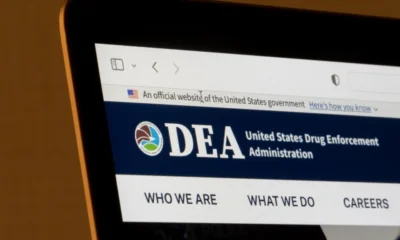Cannabis News
Smoking Hemp and Getting High?
Published
9 months agoon
By
admin

The burgeoning hemp-derived cannabinoid market often faces criticism due to the absence of standardised third-party testing and comprehensive regulation. While many consumers vouch for the efficacy of these products and numerous companies uphold stringent standards, the oversight in the hemp industry pales in comparison to that of the legal cannabis sector.
Consequently, consumers using certain hemp-derived products may unknowingly encounter potent psychoactive effects, believing they are solely consuming hemp or CBD.
The frequency of THC in goods advertised as hemp is revealed by a new study that was published in the journal Forensic Chemistry. According to the 2018 Farm Bill, items must contain less than 0.3% THC to be considered hemp and be legally permitted at the federal level.
In a recent examination, researchers from the State University of New York (SUNY) Albany and the National Institute of Standards and Technology (NIST) found that a sizable majority of smokable hemp products had THC levels higher than those allowed by the 2018 Farm Bill.
This disclosure suggests that these items belong in the cannabis category instead of the hemp category, which means they are federally illegal.
Taking a Deeper Dive into Smokable Products
The study examined 53 smokable hemp products from five commercial manufacturers, with specific products and manufacturers left unnamed. Researchers analyzed to detect various cannabinoids, including delta-8 THC, delta-9 THC, THC-A, and total delta-9 THC.
Each product, ranging from 10 to 20 grams, underwent grinding using a “small portable Magic Bullet grinder” with four to five pulses, mimicking procedures commonly employed by forensic laboratories to measure total Δ9-THC in seized cannabis plant samples. Subsequently, a methanol extraction method was employed, followed by LC-PDA analysis, which separates 11 cannabinoids in less than 10 minutes.
The findings revealed that over 90% of the samples analyzed by NIST had a total Δ9-THC mass fraction exceeding 0.3%, despite being marketed as hemp. The online documentation accompanying these samples often indicated total Δ9-THC mass fractions of ≥0.3%.
Of the hemp samples tested, approximately 93% exceeded the federal 0.3% limit, and nearly half of the provided online documents from manufacturers differed from the corresponding product labels. In a comparison between NIST results and online documentation for 22 samples, researchers observed discrepancies of approximately 55% for total Δ9-THC, 68% for THCA, and 18% for Δ9-THC.
Researchers speculated that these differences could stem from varying testing methods, inconsistent samples leading to unpredictable outcomes, batch-to-batch variability, or storage conditions. However, they also acknowledged the possibility of inaccurate product labels and online documentation contributing to the observed variations.
A Complex New Phase for Hemp-Derived Goods
“The findings underscore the necessity for precise analytical measurements, uniformity across batches, proper long-term storage conditions, and updated product information,” the authors concluded. “Moreover, these results underscore the importance of reference materials in the cannabis industry to ensure measurement precision.”
The study coincides with a growing trend among states nationwide to tighten regulations on hemp-derived cannabinoids, with some implementing stricter oversight measures and others considering outright bans on specific hemp-derived cannabinoids and related products.
Furthermore, the issue of inaccurate cannabinoid content in hemp products is not an isolated occurrence.
An analysis of hemp-derived items sold on Amazon recently concentrated on various candies, tinctures, topicals, and mints labeled as hemp products. Remarkably, more than a third of the examined items (24 out of 56, or 43%) had no hemp content, and the bulk of them (35 out of 56, or 62.5%) included no cannabinoids at all.
Unbelievably, a significant portion of the products—nearly 95% of them—lacked Certificates of Analysis (COAs), a vital document usually offered by respectable retailers of hemp goods. Furthermore, the investigation verified that a staggering 96% of the examined items lacked proper dose information.
The forthcoming revision of the Farm Bill, expected later this year, is highly anticipated to include provisions aimed at further restricting THC levels in hemp-derived products.
Addressing Regulatory Challenges and Consumer Safety Concerns
The revelations from the study underscore a pressing need for regulatory intervention and consumer safeguards in the hemp-derived cannabinoid industry. With a significant majority of smokable hemp products surpassing federal THC limits, there are glaring gaps in oversight and accountability. These findings raise concerns about consumer safety, as individuals may inadvertently be exposed to psychoactive effects when expecting non-intoxicating hemp products. It highlights the urgency for regulatory bodies to implement stricter standards, ensuring that products accurately reflect their cannabinoid content and adhere to legal thresholds.
Furthermore, disparities in manufacturer paperwork and lab studies indicate structural problems with product labeling and testing procedures. Customers who depend on reliable information to make decisions are put at risk by the inconsistent and opaque reporting of cannabis levels. This emphasizes the necessity for strict quality control procedures and uniform testing procedures throughout the hemp sector. Regulators can reduce the frequency of mislabeled items and improve customer confidence in the marketplace by providing clear criteria and enforcing compliance.
As states grapple with the burgeoning hemp-derived cannabinoid market, there is a growing trend towards tightening regulations and enforcement measures. Some states are introducing stricter oversight procedures, while others are contemplating outright bans on certain hemp-derived cannabinoids and associated products. This evolving regulatory landscape reflects efforts to address the complexities and challenges posed by the rapid expansion of the hemp industry. However, harmonizing regulations at the federal level remains crucial to ensure consistency and coherence in the marketplace.
In the future, the Farm Bill’s modification offers a chance to address the problem of THC levels in goods produced from hemp and implement significant improvements. Future measures may limit the amount of THC in products even further, bringing federal rules into line with changing consumer expectations and industry norms. Policymakers may encourage a transparent and responsible hemp industry that supports public health and trust in goods derived from hemp by proactively resolving regulatory gaps and placing a high priority on consumer safety.
Bottom Line
The study’s findings underscore the urgent need for regulatory intervention and consumer protection measures in the hemp-derived cannabinoid industry, where over 90% of smokable hemp products exceed federal THC limits. Discrepancies between lab analyses and manufacturer documentation highlight systemic issues in product labeling and testing protocols, emphasizing the necessity for consistent quality control measures. As states grapple with tightening regulations, harmonizing federal guidelines is crucial to ensure coherence across the marketplace. The forthcoming revision of the Farm Bill presents an opportunity to enact meaningful reforms and address THC levels in hemp-derived products, promoting transparency and consumer safety in the evolving hemp industry.
SMOKING HEMP AND GETTING HIGH, READ ON…
You may like
-


How The LA Fires Will Effect Cannabis Crops
-


Two Economic Forces That are Reshaping America
-


What to Expect for Global Cannabis Law Reform in 2025
-


Colorado shut out of marijuana rescheduling hearings by ‘biased’ DEA, filing alleges
-


Karma Koala Podcast 218: Bethany Niebauer Axia Resolutions (CO) – Cannabis Mediation As The Sector Matures
-


Puerto Rico Marijuana Jobs and Cannabis Careers
Cannabis News
Two Economic Forces That are Reshaping America
Published
4 hours agoon
January 8, 2025By
admin

Two Sectors of Society that’s Not Going Away…
You know that feeling when you’re comfortably high and suddenly have an epiphany about how rapidly the world is changing? Well, that’s exactly what happened to me recently while scrolling through Reddit, watching two separate conversations unfold about AI and cannabis – perhaps the two most transformative forces reshaping our society today.
The pace of change is dizzying, isn’t it? We’re living in an era where technological advancement isn’t just rapid – it’s exponential. Before we can fully grasp one innovation, three more have already emerged. And while some folks are still debating whether to embrace these changes, the train has not only left the station, it’s broken the sound barrier.
I found myself in the middle of a heated debate about AI in publishing, with some traditionally-minded writers clutching their pearls at the mere mention of using artificial intelligence in the creative process. The irony wasn’t lost on me – here they were, arguing on a digital platform about the evils of digital progress. Meanwhile, in another corner of Reddit, I stumbled upon a discussion about cannabis stocks, with one astute observer noting, “Cannabis ain’t going anywhere…”
And you know what? Both these threads got me thinking. These two sectors – AI and cannabis – share something fascinating in common: they’re both unstoppable forces that are fundamentally altering how we live, think, and interact with the world. Whether you’re excited about it or terrified, both are here to stay. The only real question is how we choose to integrate them into our society.
So pack a bowl, fire up your neural networks (both biological and artificial), and join me as we explore these transformative forces reshaping our world. Trust me, this is going to be one hell of a trip through the intersection of technology, consciousness, and social change.
Let me tell you something about revolution – it doesn’t always come with a bang. Sometimes it creeps in slowly, one dispensary at a time, one changed mind at a time, until suddenly you look around and realize the world isn’t what it used to be. That’s exactly what’s happened with cannabis over the past two decades.
Remember when California was the lone wolf with its medical marijuana program? These days, you can walk into a dispensary in more than half of U.S. states and legally purchase cannabis. Hell, you can even light up legally in Germany now. The transformation has been nothing short of remarkable, even if 2024 saw a slight slowdown in the legalization momentum. But make no mistake – this train isn’t stopping. It might hit some speed bumps, but it’s still chugging along toward full legalization.
Now, I know what you’re thinking: “But Reg, what about the upcoming Trump administration? Won’t that put the brakes on everything?” Look, I’ve spent enough time analyzing cannabis policy to know that nothing’s certain in politics. But here’s the interesting part – there’s actually some reason for optimism. With RFK Jr. potentially heading up Health and Human Services, we might see some surprising moves. I’ve written before about how a well-crafted legalization plan could actually be a winner with a Republican-controlled government. Tax revenue, states’ rights, personal freedom – these are concepts that resonate across party lines.
But let’s be real for a minute. Whether it happens under Trump or the next administration or the one after that, cannabis legalization is inevitable. You can’t put this genie back in the bottle. We’re talking about an industry generating billions in legal revenue annually. The cannabis sector isn’t just some hippie dream anymore – it’s a serious economic force with real jobs, real tax revenue, and real political clout.
And here’s the kicker – demographics are destiny. The reefer madness generation is fading away, replaced by millennials and Gen X parents who’d rather spark a joint than open a bottle of wine after putting the kids to bed. Cannabis has been normalized to a degree that would have been unthinkable twenty years ago. When soccer moms are discussing their favorite strains at PTA meetings and grandma is using CBD for her arthritis, you know the cultural shift is complete.
The future is clear: federal legalization in the U.S. is coming, and international legalization will follow. It’s not a matter of if, but when. And when that day comes, we’ll look back at this period of transition and wonder why it took so long to embrace what humans have known for thousands of years – that this plant has the power to heal, to inspire, and to bring people together.
You know what’s wild? While I’ve been covering cannabis for years, watching it slowly transform from counterculture to mainstream, artificial intelligence swooped in like a technological tornado and turned everything upside down practically overnight. And I mean everything.
Let me get personal for a minute. As someone who’s made their living stringing words together, I’ve had a front-row seat to this revolution. Where I used to have editors throwing assignments my way like joints at a Cypress Hill concert, nowadays those gigs have become as rare as schwag weed in a Colorado dispensary. And I’m not alone – this disruption is hitting everyone from artists to lawyers, doctors to factory workers.
Recently, I found myself in the crosshairs of this debate when I mentioned my latest project – a 90,000-word fiction book I’m creating with AI assistance. You’d think I’d announced I was mixing oregano with my cannabis, the way some people reacted. The downvotes came faster than munchies after a dab session. But here’s the thing: I’m not just feeding prompts into a machine and calling it a day. I’m channeling my creativity through this new tool, directing it like a conductor leads an orchestra. Every plot point, every character arc, every emotional beat – that’s all coming from my creative vision.
But try explaining that to the traditionalists. They insist it’s not “real” writing if AI is involved. It’s like arguing with someone who still believes in Reefer Madness – they’re so caught up in their preconceptions that they can’t see the bigger picture. The reality is, this technology isn’t going away. Just like cannabis legalization, we’re past the point of no return.
And let’s be real – this is just the beginning. While I’m catching flak for using AI in writing, companies like Tesla and Boston Dynamics are developing robots that could replace entire workforces. Couple that with AI, and suddenly you don’t need human workers, floor managers, or even middle management. It’s enough to make anyone paranoid, and this time, it’s not the weed talking.
The question isn’t whether AI will transform society – it’s already happening. The real question is what happens to those who can’t or won’t adapt. I’ve chosen to lean into it because I see the writing on the wall. In a few years, companies won’t be hiring copywriters; they’ll be hiring “prompters” who know how to dance with the AI to get results. And they’ll do it for a fraction of what they’re paying now.
Here’s the kicker though – just like cannabis, AI has the potential to either enhance our lives or cause serious problems, depending on how we handle it. The genie’s out of the bottle, folks, and it’s smoking something a lot stronger than we ever imagined. The only choice we have is whether we learn to work with it or let it work us over.
Look, I’ve been around long enough to know when something’s here to stay. Cannabis and AI aren’t just trends – they’re transformative forces reshaping our world faster than you can clear a bong. And just like that friend who says they’ll “just take one hit,” there’s no going back once you start.
The writing isn’t just on the wall anymore; it’s being projected in 8K resolution by an AI while someone blazes a joint in the corner. These industries aren’t just growing; they’re intertwining with every aspect of our lives. Fighting against this reality is like trying to push smoke back into a bowl – pointless and probably going to give you a headache.
So here’s my advice, for what it’s worth: Find your place in this brave new world. Maybe that means developing cannabis-infused products that no one’s thought of yet. Maybe it means becoming the go-to AI prompt engineer for dispensaries looking to automate their marketing. Hell, maybe it means combining both – using AI to optimize grow operations or predict cannabis market trends.
The point is, you can either evolve or get left behind, reminiscing about the “good old days” like that one uncle who still thinks “pot needles” are a thing. And let me tell you, I’ve seen enough of those folks – bitter, resistant to change, watching the world pass them by while they clutch their outdated beliefs like a security blanket.
The future is coming, whether we’re ready or not, and it’s bringing both heavy tech and heavy hits with it. You can either grab your piece of the pie or watch others feast. Personally, I’d rather be at the table than watching through the window.
Remember this: the future is red-eyed and running on neural networks, and no amount of clutching pearls or crying about “the way things used to be” is going to change that. So spark up, power up, and get ready for the ride – it’s going to be one hell of a trip.
HUMANS AND AI, NOT THE FIRST GO-AROUND? READ ON…
Cannabis News
What to Expect for Global Cannabis Law Reform in 2025
Published
5 hours agoon
January 8, 2025By
admin
As the U.S. cannabis community awaits the resumption of the DEA’s administrative law hearing on rescheduling marijuana later this month, this blog will take a glimpse at the ever-dynamic global landscape of cannabis policy. While some countries may expand, retract, or maintain the progress seen in 2024, much attention will focus on the key developments that marked the past year. Notably, Europe saw significant movement in cannabis policy.
Key global cannabis law developments in 2024
- Germany passed a quasi-legalization law with two phases. Phase I, implemented in 2023, legalized cannabis cultivation clubs, home cultivation, and personal possession. Phase II, still in the early planning stages, would introduce regulated marijuana sales through pilot programs. The most impactful change, however, has been the expansion of medical marijuana access, which has surged since the law’s enactment.
- Poland’s Parliamentary Committee on Petition presented a proposal to decriminalize personal marijuana possession and home cultivation to the Prime Minister. While the proposal is not binding, it could pave the way for future progress, contingent on the outcome of Poland’s May presidential election.
- The Netherlands, after multiple delays, is poised to meet demand for regulated marijuana through licensed cultivators supplying coffee shops participating in the trial, marking a significant step in its regulated cannabis market.
- Switzerland expanded its pilot program for the regulated sale of marijuana to more jurisdictions.
- Ukraine legalized medical marijuana for specific qualifying conditions, marking a major health policy milestone.
- Thailand, under its new conservative government, opted to regulate rather than reschedule marijuana.
- Australia held a vote to legalize marijuana at the end of 2024. The vote failed by a vote of 24-13, but this was a monumental step in the country’s shift away from the war on drugs.
- Italy’s conservative leadership has pushed to ban hemp flower-based products, prompting hemp industry advocates to call for an immediate review of the law’s compatibility with EU regulations. The European Commission’s review could determine the future of Italy’s hemp industry.
What to expect for global cannabis law developments in 2025
Despite the promising advances in 2024, 2025 may see increased resistance from conservative governments opposed to cannabis liberalization. Several countries may face setbacks or even roll back their cannabis reforms:
- Germany: While several municipalities, including Frankfurt, are moving forward with commercial cannabis pilot programs, the Christian Conservative Party, expected to gain control after February’s snap elections, has indicated opposition to further expansion, particularly Phase II. Despite this, a poll showing 59% support for marijuana legalization suggests that a full reversal of Phase I is unlikely. Even if the Christian Conservatives take power, recriminalizing cannabis would be difficult without forming a coalition that includes pro-cannabis parties, which is unlikely. Thus, while pilot programs may be at risk, the current system isn’t likely to be reversed.
- The Netherlands: Despite a rightward shift in the 2023 elections, the governing coalition has confirmed it will not halt the regulated coffee shop trials. Delayed by supply issues, these trials are now set to fully implement regulated sales by April of this year.
- Thailand: Following its election win in 2023, the Pheu Thai Party which initially campaigned on placing cannabis back on the controlled substances list, has softened its stance. The Party’s initial plans to criminalize marijuana appear to be off the table. The government is now focused on regulating the cannabis market, which may include some form of regulated commercial sales. Restrictions will likely be placed on the current unregulated market, but the shift towards regulation suggests that prohibition is not on the horizon. This move could also position Thailand for entry into the global medical marijuana trade.
- Czech Republic: Initially aiming for full legalization of commercial cannabis, the Czech Republic shifted focus in 2024 under pressure from the EU regarding UN treaty obligations. Chechia is seeking a framework similar to Germany’s, with provisions for personal cultivation and possession limits. Additionally, the government is working on a regulatory regime for low-THC hemp (not exceeding 1%), including HHC, as part of its “Psychomodulatory Substances” regime.
- Ukraine: Ukraine’s medical marijuana program, which has faced delays, is set to roll out in early 2025. Initially, it will only serve patients with specific forms of cancer and war-related PTSD. While access will be highly restricted, there is hope that additional conditions may be included in the future. Currently there are no medical marijuana products available to patients, but that is expected to change in early 2025.
Big picture thoughts for cannabis law in 2025
In 2025, conservative governments may pose challenges to expanding cannabis reforms. However, the full repeal of existing cannabis laws seems unlikely.
Recently, the United Nations High Commissioner for Human Rights underscored the failure of the War on Drugs and advocated for a shift toward regulatory frameworks that prioritize public health over punitive measures. These “alternative regulatory approaches” seek to reduce the influence of the black market and cartels, boost tax revenues, and fund social programs aimed at mitigating the impact of drugs on society.
Hopefully these principles will gain traction, and governments will continue moving away from the failed war on drugs in favor of common-sense cannabis regulation.
Cannabis News
Maintaining The Highest Level of Quality and Freshness for THCa Products
Published
1 day agoon
January 7, 2025By
admin

When looking for food, the freshness and quality of the product are essential to the customer. Care must be taken with every product to keep its original qualities. This makes sure that customers have the best experience possible with every buy. Brands ensure their products stay potent and fresh, so to maintain they put them in airtight containers. This gives customers a premium experience that stands out in the market even if they are bought from thca flower clearance. This is especially important when it comes to cannabis goods. Keeping THC-rich flowers fresh ensures every person has a good experience that meets their needs.
The practice of storing things in air-tight containers is very helpful for maintaining their quality. These containers help keep out air, light, and wetness, which can all make the product fresh and effective over time. For people who use cannabis, how fresh the product is can have a big effect on how strong and how long the benefits last. When THC flowers are stored properly, users can expect a better experience that keeps all of the product’s benefits.
The chemicals that give weed its unique tastes and smells, don’t break down when it is stored in an airtight container. Terpenes are very important for improving the taste and making each type unique. The natural qualities of these terpenes can be kept safe by storing them in the right way. This way, every user can enjoy the full range of tastes and smells that the product has to offer.
Why airtight containers are important
Containers that don’t let air in are not only useful, they are necessary for storing things. Over the time, oxygen can break down the product’s cannabinoids and oils. When you use airtight cases, the product stays protected from the outside world. This keeps its chemical structure and makes sure it stays strong.
The users will trust the products only if they feel good about quality. Whether they are used for fun or medical reasons, THC flowers if not stored correctly may have less effect, giving a bad experience for users. To keep the level of quality, it is important to spend money on good storage methods like using airtight containers.
Make sure you have a great time
When a product has been carefully stored in the best possible ways, the experience is more powerful. Whether you are buying flowers to help you feel better or just for fun, they should always be live. With this care, users can get a product that works well like they bought the day it was packaged.
Freshness is at the heart of this process. By making sure that goods are kept in containers that keep air out, businesses can keep up the quality of the goods and make sure that customers can get the best items. Customers are happier and more likely to trust the brand to always provide better goods.
In the end, keeping the product fresh and high-quality isn’t just about keeping it safe, it is also about giving the customer a regular, good experience. Making sure that a product stays fresh and effective from the time it is packed until it gets to the customer is very important. One easy and very effective way to reach this goal is to store things in containers that keep air out. Looking at good storage methods will continue to be important for keeping the quality of THC products even as the cannabis business grows. Customers can be sure that this way of keeping things fresh and effective will make their experience better, whether they are looking for new types or taking advantage of thca flower clearance deals.

How The LA Fires Will Effect Cannabis Crops

Two Economic Forces That are Reshaping America

What to Expect for Global Cannabis Law Reform in 2025

Colorado shut out of marijuana rescheduling hearings by ‘biased’ DEA, filing alleges

Karma Koala Podcast 218: Bethany Niebauer Axia Resolutions (CO) – Cannabis Mediation As The Sector Matures

Puerto Rico Marijuana Jobs and Cannabis Careers

How to Become a Budtender in Pennsylvania

5 Marijuana-Infused Food Recipes You Can Make at Home

How to Make No Bake Edibles With Cannabutter: Easy Recipes

Dante’s Inferno Cannabis Strain Overview

Distressed Cannabis Business Takeaways – Canna Law Blog™

United States: Alex Malyshev And Melinda Fellner Discuss The Intersection Of Tax And Cannabis In New Video Series – Part VI: Licensing (Video)

What you Need to Know

Drug Testing for Marijuana – The Joint Blog

NCIA Write About Their Equity Scholarship Program

It has been a wild news week – here’s how CBD and weed can help you relax

Cannabis, alcohol firm SNDL loses CA$372.4 million in 2022

A new April 20 cannabis contest includes a $40,000 purse

Your Go-To Source for Cannabis Logos and Designs

UArizona launches online cannabis compliance online course
Trending
-

 Cannabis News2 years ago
Cannabis News2 years agoDistressed Cannabis Business Takeaways – Canna Law Blog™
-

 One-Hit Wonders2 years ago
One-Hit Wonders2 years agoUnited States: Alex Malyshev And Melinda Fellner Discuss The Intersection Of Tax And Cannabis In New Video Series – Part VI: Licensing (Video)
-

 Cannabis 1012 years ago
Cannabis 1012 years agoWhat you Need to Know
-

 drug testing1 year ago
drug testing1 year agoDrug Testing for Marijuana – The Joint Blog
-

 Education2 years ago
Education2 years agoNCIA Write About Their Equity Scholarship Program
-

 Cannabis2 years ago
Cannabis2 years agoIt has been a wild news week – here’s how CBD and weed can help you relax
-

 Marijuana Business Daily2 years ago
Marijuana Business Daily2 years agoCannabis, alcohol firm SNDL loses CA$372.4 million in 2022
-

 California2 years ago
California2 years agoA new April 20 cannabis contest includes a $40,000 purse





